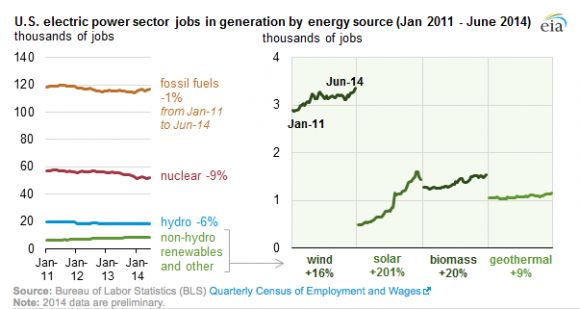The electric power sector lost more than 5,800 jobs over the last three years, with employment is taking a hit in nearly all energy sources except for renewables, according to the Energy Information Administration (EIA).
Non-hydro renewable electricity generation gained nearly 1,800 jobs over the period, largely in the solar sector.
Data compiled from the Bureau of Labor Statistics only reflects the jobs in electric power generation, and not the jobs associated with managing the grid. Jobs related to the construction of new facilities, processing or transportation of fuels, or behind-the-meter distributed generation installations and service were also excluded from the number set.
The overall decline in jobs comes as growth in U.S. electricity demand has come to a standstill, due to energy efficiency upgrades and growth in distributed energy resources, like rooftop solar, among other things. In California, for instance, distributed PV reduced electricity demand growth by 47 percent last year, according to GTM Research.
Between June 2011 and June 2014, the number of jobs related to the operation of solar generation installations more than tripled, increasing from roughly 500 to 1,500. The Solar Foundation is expected to release a more comprehensive job report in the new year. As the solar industry continues to grow, some have highlighted the need to ensure women, veterans and racial minorities have access to jobs in the sector.
Wind, biomass and geothermal also saw significant job growth in that timeframe. While wind jobs grew at a slower pace than solar over the same period, increasing 16 percent versus 201 percent for solar, there are still more than twice as many wind jobs in the electric power sector.

Jobs in hydropower generation fell by 6 percent between 2011 and 2014, but are still more than double all jobs in non-hydro renewable generation put together.
While natural gas capacity additions spurred job growth, recent coal plant closures caused a net decline of 1,750 fossil fuel power generation jobs since 2011. According to the EIA, the new natural gas plants are less labor-intensive than the older coal plants they’re replacing.
The nuclear industry, however, was the hardest hit. Jobs at nuclear power plants fell by 9 percent, which amounts to 4,900 positions, over the last three years.
The downward trend is on track to continue. Several U.S. nuclear power plants are slated for closure in the coming years and there are next to no plans to replace them. The International Energy Agency, a leading Washington think tank and group of conservation scientists recently made separate appeals for the U.S. to rethink its nuclear energy strategy.



